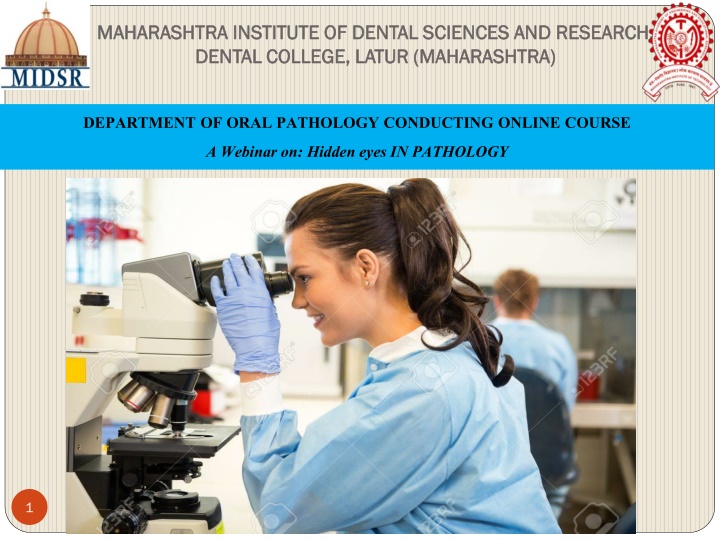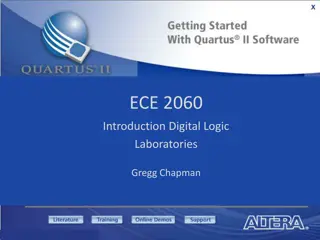
Exploring Microscopy in Dental Pathology and Research
Discover the fundamentals of microscopy in dental pathology through an online course offered by the Maharashtra Institute of Dental Sciences and Research. Gain insights into the operation of various microscopes used in histology units and laboratories, enhancing your understanding of tissue structures and functions for research and diagnostic purposes.
Download Presentation

Please find below an Image/Link to download the presentation.
The content on the website is provided AS IS for your information and personal use only. It may not be sold, licensed, or shared on other websites without obtaining consent from the author. If you encounter any issues during the download, it is possible that the publisher has removed the file from their server.
You are allowed to download the files provided on this website for personal or commercial use, subject to the condition that they are used lawfully. All files are the property of their respective owners.
The content on the website is provided AS IS for your information and personal use only. It may not be sold, licensed, or shared on other websites without obtaining consent from the author.
E N D
Presentation Transcript
MAHARASHTRA INSTITUTE OF DENTAL SCIENCES AND RESEARCH, MAHARASHTRA INSTITUTE OF DENTAL SCIENCES AND RESEARCH, DENTAL COLLEGE, LATUR (MAHARASHTRA) DENTAL COLLEGE, LATUR (MAHARASHTRA) DEPARTMENT OF ORAL PATHOLOGY CONDUCTING ONLINE COURSE A Webinar on: Hidden eyes IN PATHOLOGY 1
DEPARTMENT OF ORAL PATHOLOGY AND DEPARTMENT OF ORAL PATHOLOGY AND MICROBIOLOGY MICROBIOLOGY A Webinar on: Hidden eyes IN PATHOLOGY A Webinar on: Hidden eyes IN PATHOLOGY 2
What comes in your mind after seeing the course brochure? 3
From where or from which standard you have started using microscope? 5
Which type of microscope you have seen/used till date? 6
INTRODUCTION INTRODUCTION This course provides an introduction to microscopy and the operation of a various types of microscopes found in histology units and teaching laboratories. Microscope, instrument that produces enlarged images of small objects, allowing the observer an exceedingly close view of minute structures. Understanding the capabilities and limitations of the microscope is important if one is to get the best results from microscopy. The microscope is a very powerful tool for understanding the structure and function of tissues, and it is widely used in biomedical sciences, as well as in research and diagnostic laboratories. The ability to identify structures and specific cell types has been greatly aided by different microscopes. The investigation of cell structure has also been considerably extended by the developments in electron microscopy and fluorescence microscopy. 8
Microscopy is the art of using microscopes to find, examine and discover things that cant be seen with the naked eye. Microscopes come in many different types, each of which has distinct functions and applications. However in a routine histology department, virtually all of the work is done using with transmitted light, meaning that the light passes through the section to the objective lens. This arrangement is called bright field microscopy, because the background appears bright. a light microscope, 9
This instrument has been perfected over the past 300 years. It has, within limits, allowed the invisible to become the visible. The purpose of this basic course training is to explain how the microscope achieves these tasks and to explain the components and their use in simple and nontechnical language. It outlines different methods used for preparing and staining tissue sections for microscopy, and explains how different stains can be used to identify particular cells, pathogens and anatomical structures. 10
This online comprehensive course begins with basics of simple microscopy proceeds through transmitted light microscopy covers the various methods of imaging fluorescent samples, describes how cameras work and image processing and concludes with latest advances in microscopy. In addition to lecture we also provide video demonstrations and short tips, so as to cover pragmatics of how to use microscope. 11
Advances in science and technology have also profoundly changed the face of light microscopy over the past ten years. Instead of microscope and film camera, the light microscope is now commonly integrated with a CCD camera, computer, software, and printer into electronic imaging systems. Therefore, to use a modern research microscope, it is clear that research scientists need to know not only how to align the microscope optics, but also how to acquire electronic images and perform image processing. 12
The Human Eye The Human Eye The microscope is a valuable instrument. There are many small objects or details of objects which cannot be seen by the unaided human eye. The microscope magnifies the image of such objects thus making them visible to the human eye. You will find that almost everything (alive or that was not alive) consists of components called cells and they take on a fabulous view at the cellular structure like your own blood, molds, yeast, and bacteria. 13
Microscopic Eye! Microscopic Eye! What you make it seeing with microscopic eyes? What you see it with eyes? What you see it with eyes? Normal will become extraordinary when looking through a microscope. 14
Why to Use Microscopes? Why to Use Microscopes? See things (objects,organisms) that are not visible with naked eye Study morphological properties at micro- and nano-scale lengths Observe live phenomena (live cells) under microscope Microscopy is a mainstay of primary health care, including programmes to diagnose of various pathologies Microscopes are essential tools in creating new medicines and finding cures for diseases 20
Histopathologic analysis using the conventional light microscopy has been the gold standard for cancer detection and grading for decades. Due to the growing field of pathology, more and more histology slides are becoming available. This improves the accessibility, allows teleconsultations from specialized pathologists, improves education, and might give pathologist to review the slides in patient management systems. Using different microscopes become easier to the pathologists to fully understand the growth pattern of a tumor, tumor invasion. The pathologist examines the slides by looking at morphological changes. Using different magnifications, the aggressiveness of tumor cells is graded, and the staging is performed along with the treatment planning 21
Training Modules Training Modules Goal of this training module is how to teach the beginner how to use microscopes A brief background on microscopes and microscopy How to maintain a microscope in good condition. Describe routine maintenance procedures Dos and Don ts for proper use of the microscope. 22
ABOUT THE COURSE This course is an online course offered by Department of Oral Pathology, MIDSR College Latur. This Microscopy course is an understanding of the theoretical background as well as practical skills of various types of microscopes. Lectures are followed by practical demonstrations. This course provides an introduction to microscopy and operation of a various types of microscope. 23
Course learning outcome: After this course, you will be able to identify and understand the basic principal components of simple and compound microscope, working principals and advances of specialized microscope, its set- up and uses. 24
Objectives of the Training: To identify and understand the working principals of simple and light microscope To identify and understand the working principal of specialized microscope To understand the microscopic advantages. 25
Learning Resources: A variety of learning resources will be utilized in terms of lectures with power point presentations & videos Course Assessment : Assessment of student will be done on the basis of exercises (slide tests and interactive sessions) allotted to them along with 10 marks MCQ s question. Assessments are provided for each lecture 26
Course certification: At the end of 4th module participants will be presented with the certificate; provided that he/she should complete the course. 27
Without pathologist the diagnosis remains inconclusive. and without microscope, the pathologist remains helpless. 28
DEPARTMENT OF ORAL PATHOLOGY CONDUCTING ONLINE COURSE A Webinar on: Hidden eyes IN PATHOLOGY COURSE DETAILS Date TOPIC SPEAKER 31-07-2020 MODULE-I Dr. Varsha and Dr. Smita Dr. Anuja Introduction and Registration 1-08-2020 Basic Principal of Simple Microscope 07-08-2020 Dr. Varsha Compound microscope MODULE-II 08-08-2020 Dr. Smita Specialized microscope: Part-1 Dark-field and phase contrast 14-08-2020 Dr. Anuja Specialized microscope: Part-2 Polarized microscope MODULE-III Specialized microscope: Part-3 Fluorescent microscope 21-08-2020 Dr. Varsha 28-08-2020 Electron microscope Dr. Smita 29-08-2020 MODULE-IV Dr. Anuja Interference, Confocal and Stereo microscope REGISTRATION DETAILS: Free online registration: oralpath@mitmidsr.edu.in Mr. Shaikh: 9921885285 29












